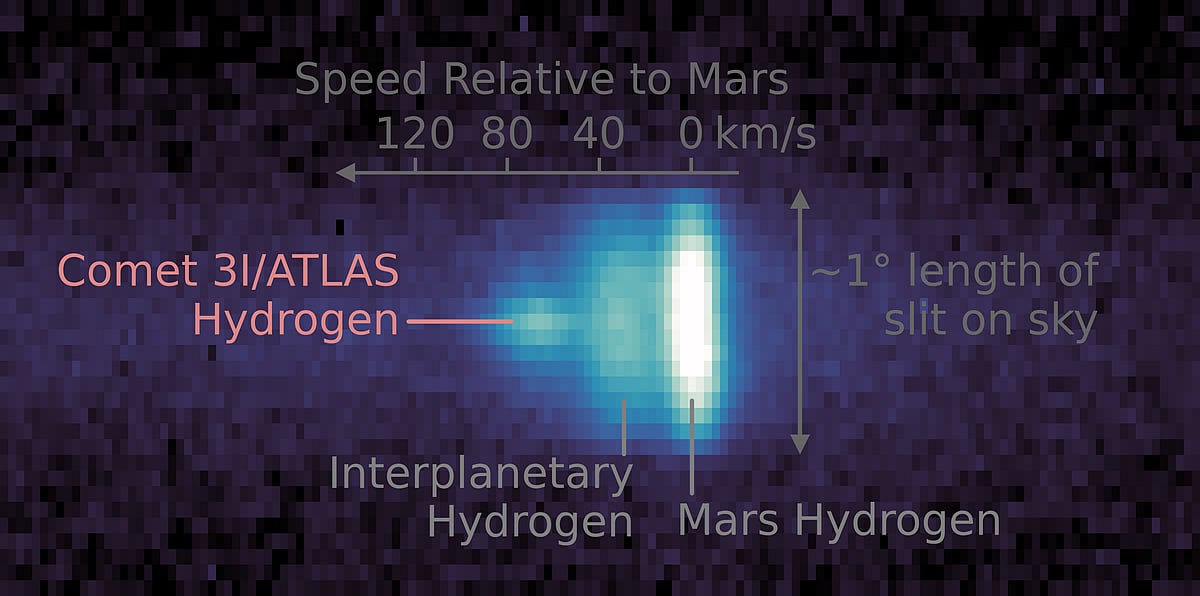Comet 3I/ATLAS Images: NASA Faces Backlash For Sharing 'Blurry' Photos; 'Is It A Joke?'
NASA’s latest images of interstellar comet 3I/ATLAS triggered widespread online criticism after users mocked the blurry visuals shared by the space agency.

NASA has released new images of the interstellar object 3I/ATLAS, a comet believed by astronomers to be older than the solar system, while also dismissing speculation that the object might be an alien spacecraft.
In a post on X, the space agency wrote, "We've just released the latest images of the interstellar comet 3I/ATLAS, as observed by eight different spacecraft, satellites, and telescopes."
We've just released the latest images of the interstellar comet 3I/ATLAS, as observed by eight different spacecraft, satellites, and telescopes.
— NASA (@NASA) November 19, 2025
Here's what we've learned about the comet â and how we're studying it across the solar system: https://t.co/ZIt1Qq6DSp pic.twitter.com/ITD6BqVlGn
However, the visuals, captured from long distances, showed the comet with a noticeably blurry appearance. Users on X were swift to criticise NASA for sharing what many described as low-quality pictures.
One user commented, "After all these days of delay and hype, this is the pixelated picture that NASA released of 3I/Atlas."
After all these days of delay and hype, this is the pixelated picture that NASA released of 3I/Atlas
— Salman. â³ â â (@SalmanNaseer) November 19, 2025
LMFAOOOO IS THIS A JOKE pic.twitter.com/A0wCuDXJ4G
Another user commented that NASA had oversold the release. The user wrote that the so-called reveal amounted to "a blurry smudge at 29M km…smeared by diffraction and atmospheric noise" rather than meaningful science. They added that presenting it as a major achievement was "a blatant disservice to taxpayers and truth-seekers," especially when "JWST, VLT, and Hubble deliver far superior views."
@NASA, your Nov 19, 2025 âgrand revealâ of interstellar comet 3I/ATLAS via HiRISE? A blurry smudge at 29M km, ~30 km/pixel resolution, smeared by diffraction and atmospheric noiseâyet you parade it as cutting-edge science? This is a blatant disservice to taxpayers and⦠pic.twitter.com/5a6bQ7lPtI
— Mateusz (@ToeMateusz) November 19, 2025
Sarcasm also flowed freely. One user wrote, "Amazing shot. I didn’t even know people still use Polaroid film!"
Amazing shot. I didnt even know people still use Polaroid film!
— Court Jester (@NY1SRED) November 20, 2025
Another comment mocked NASA for being outdone by amateurs, saying its "'groundbreaking'… $30 billion" reveal was just "a blurry white dot with a fuzzy halo," while "some dude in his backyard with a $500 Walmart telescope" managed a far clearer shot. The user also shared side-by-side comparisons of NASA’s photo and the amateur shot.
NASA just dropped their "groundbreaking" new images of 3I/ATLAS after a $30 billion budget and months of hype...It's a blurry white dot with a fuzzy halo. Meanwhile, some dude in his backyard with a $500 Walmart telescope and a Red Bull just stacked this absolute banger showing⦠pic.twitter.com/QAvkCoc9TS
— Nibiru (@JinxedHorizon) November 19, 2025
Another user said, "We’ve got citizen astronomers out here taking better photos of 3I/ATLAS than NASA."
One user called out the effort and expense behind the image, suggesting that despite paying millions, all NASA produced was underwhelming. "They paid someone a few million dollars to get a picture, and all they got was a motorcycle on a foggy night," wrote the user.
NASA Under Fire On Social Media:
BREAKING: a blur of light in a black box has been confirmed as meaningful.
— Delete Your Handler (@thebeaconsignal) November 19, 2025
We gave it a name. You may now worship.
Eight spacecraft.
Six satellites.
Forty billion dollars.
And they still canât fix your tap water.
The spell is simple.
Point to the stars.
Call itâ¦
No, you can't have managed to get worse footage than amateurs with such a big budget. You should stop making fun of people because the masses have woken up and want to know the truth.
— ZA (@LaikCumhuriyett) November 19, 2025
(Ray's Astrophotography /Youtube)
OKAY! pic.twitter.com/yNcgeqLGxY
Dear @NASA I will gladly give you my Samsung Galaxy S25 Ultra so you may take reasonable pictures.
— DronePro (@DronePro) November 19, 2025
Is it a joke? https://t.co/G40r5cMS55
— Astronomy Vibes (@AstronomyVibes) November 19, 2025
Observations From Multiple Angles
In a blog post, NASA said 12 of its assets captured images of 3I/ATLAS since its discovery on July 1, with more expected as it moves through the solar system.
"By observing the comet from so many locations, NASA has an opportunity to learn about the ways that 3I/ATLAS differs from our solar system’s home-grown comets and give scientists a new window into how the compositions of other systems may differ from our own," NASA said.
Close Views From Mars Missions
The closest shots came from Mars, where the comet passed 19 million miles away. The Mars Reconnaissance Orbiter captured near views, MAVEN obtained ultraviolet images to study its composition and the Perseverance rover caught a faint glimpse from the surface.

According to a Reuters report, 3I/ATLAS was first spotted in July by the ATLAS telescope in Rio Hurtado, Chile. Its unusual trajectory confirmed it as an interstellar visitor.

